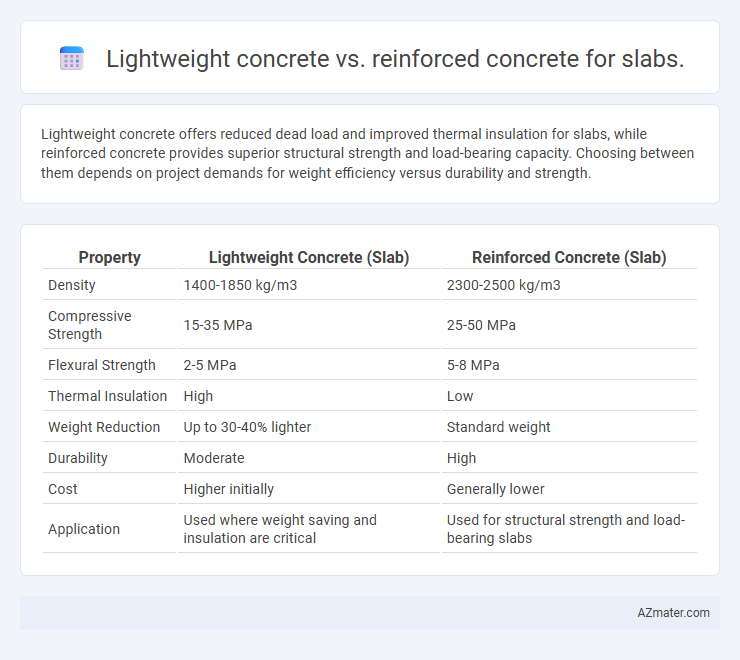Lightweight concrete offers reduced dead load and improved thermal insulation for slabs, while reinforced concrete provides superior structural strength and load-bearing capacity. Choosing between them depends on project demands for weight efficiency versus durability and strength.
Table of Comparison
| Property | Lightweight Concrete (Slab) | Reinforced Concrete (Slab) |
|---|---|---|
| Density | 1400-1850 kg/m3 | 2300-2500 kg/m3 |
| Compressive Strength | 15-35 MPa | 25-50 MPa |
| Flexural Strength | 2-5 MPa | 5-8 MPa |
| Thermal Insulation | High | Low |
| Weight Reduction | Up to 30-40% lighter | Standard weight |
| Durability | Moderate | High |
| Cost | Higher initially | Generally lower |
| Application | Used where weight saving and insulation are critical | Used for structural strength and load-bearing slabs |
Introduction to Lightweight and Reinforced Concrete Slabs
Lightweight concrete slabs are composed of aggregates like expanded clay, shale, or pumice to reduce density, enhancing thermal insulation and reducing dead load on structures. Reinforced concrete slabs integrate steel bars or meshes, providing high tensile strength and durability for load-bearing applications. Selection between lightweight and reinforced concrete slabs hinges on factors such as structural requirements, thermal performance, and overall weight considerations.
Composition of Lightweight Concrete Slabs
Lightweight concrete slabs are composed primarily of lightweight aggregates such as expanded clay, shale, or pumice, which reduce the overall density and improve thermal insulation compared to traditional reinforced concrete slabs made with normal-weight aggregates like gravel and sand. The matrix in lightweight concrete incorporates cement, water, and occasionally supplementary cementitious materials such as fly ash or silica fume to enhance strength and durability while maintaining reduced weight. This composition results in slabs with lower dead loads, allowing for longer spans and reduced structural support requirements compared to conventional reinforced concrete slabs.
Structure of Reinforced Concrete Slabs
Reinforced concrete slabs consist of a concrete matrix embedded with steel reinforcement bars or mesh, providing enhanced tensile strength and load-bearing capacity compared to lightweight concrete slabs. The structure of reinforced concrete slabs involves carefully designed reinforcement layout to resist bending, shear, and torsion forces, ensuring durability and structural integrity under various loads. Unlike lightweight concrete, which prioritizes reduced density and thermal insulation, reinforced concrete slabs emphasize robust structural performance and longevity in construction applications.
Key Mechanical Properties Comparison
Lightweight concrete exhibits lower compressive strength, typically ranging from 8 to 20 MPa, whereas reinforced concrete slabs often reach 25 to 40 MPa, providing higher load-bearing capacity. The modulus of elasticity for lightweight concrete is around 10 to 18 GPa, which is significantly less than the 25 to 35 GPa observed in reinforced concrete, impacting stiffness and deflection performance. Reinforced concrete's superior tensile strength, enhanced by steel reinforcement, offers improved crack resistance compared to lightweight concrete, making it more suitable for heavy-load slab applications.
Weight and Load-bearing Capabilities
Lightweight concrete slabs reduce structural weight by incorporating low-density aggregates, resulting in approximately 20-30% less weight compared to traditional reinforced concrete slabs. Reinforced concrete slabs exhibit superior load-bearing capabilities due to embedded steel reinforcement, enabling them to withstand higher tensile and compressive stresses. Choosing lightweight concrete optimizes structural efficiency in applications where reducing dead load is critical, while reinforced concrete ensures maximum strength and durability for heavy-load scenarios.
Insulation and Thermal Performance
Lightweight concrete offers superior insulation and thermal performance for slabs due to its lower density and higher air content, which reduces heat transfer and energy consumption. Reinforced concrete slabs provide structural strength but have higher thermal conductivity, leading to increased heat loss and less effective insulation. Selecting lightweight concrete enhances energy efficiency and indoor comfort by minimizing thermal bridging compared to traditional reinforced concrete slabs.
Durability and Longevity
Lightweight concrete offers enhanced durability for slabs due to its lower density, improved thermal insulation, and resistance to freeze-thaw cycles, reducing cracking over time. Reinforced concrete slabs exhibit superior structural strength and longevity by integrating steel reinforcement, which manages tensile stresses and prevents brittle failure under heavy loads. The durability of reinforced concrete is contingent on effective corrosion protection of steel, while lightweight concrete's longevity benefits from reduced dead load and shrinkage.
Cost Implications and Material Availability
Lightweight concrete slabs reduce overall structural dead load, decreasing foundation costs but often incur higher material expenses due to specialized aggregates. Reinforced concrete slabs use standard aggregates and widely available steel rebar, offering cost advantages in raw materials and labor in regions with established supply chains. Material availability for lightweight concrete can be limited in some areas, increasing procurement costs and lead times compared to the more universally accessible components of reinforced concrete.
Applications and Suitability for Projects
Lightweight concrete is ideal for slabs in high-rise buildings and structures requiring reduced dead load, offering improved thermal insulation and ease of handling. Reinforced concrete slabs excel in projects demanding high strength and durability, such as industrial floors and bridges, due to the embedded steel reinforcement providing superior tensile resistance. Selection depends on load requirements, structural design, and project conditions, with lightweight concrete favored for cost-effective, non-load-bearing applications and reinforced concrete preferred for load-bearing and heavy-duty slabs.
Conclusion: Selecting the Right Slab Material
Lightweight concrete offers the advantage of reducing dead load, making it ideal for structures requiring lower weight without compromising thermal insulation. Reinforced concrete, however, provides superior strength and durability, especially essential for slabs subjected to heavy loads and high stress. Choosing between lightweight and reinforced concrete for slabs depends on balancing weight reduction needs with structural performance requirements and project cost considerations.

Infographic: Lightweight concrete vs Reinforced concrete for Slab
 azmater.com
azmater.com